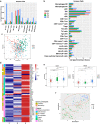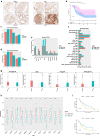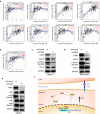Immune subtyping for pancreatic cancer with implication in clinical outcomes and improving immunotherapy
- PMID: 33637086
- PMCID: PMC7908647
- DOI: 10.1186/s12935-021-01824-z
Immune subtyping for pancreatic cancer with implication in clinical outcomes and improving immunotherapy
Abstract
Background: Emerging evidence has shown that intra-tumor immune features are associated with response to immune checkpoint blockade (ICB) therapy. Accordingly, patient stratification is needed for identifying target patients and designing strategies to improve the efficacy of ICB therapy. We aimed to depict the specific immune features of patients with pancreatic cancer and explore the implication of immune diversity in prognostic prediction and individualized immunotherapy.
Methods: From transcriptional profiles of 383 tumor samples in TCGA, ICGC, and GEO database, robust immune subtypes which had different response immunotherapy, including ICB therapy, were identified by consensus clustering with five gene modules. DEGs analysis and tumor microarray were used to screen and demonstrate potential targets for improving ICB therapy.
Results: Three subtypes of pancreatic cancer, namely cluster 1-3 (C1-C3), characterized with distinct immune features and prognosis, were generated. Of that, subtype C1 was an immune-cold type in lack of immune regulators, subtype C2, with an immunosuppression-dominated phenotype characterized by robust TGFβ signaling and stromal reaction, showed the worst prognosis, subtype C3 was an immune-hot type, with massive immune cell infiltration and in abundance of immune regulators. The disparity of immune features uncovered the discrepant applicability of anti-PD-1/PD-L1 therapy and potential sensitivity to other alternative immunotherapy for each subtype. Patients in C3 were more suitable for anti-PD-1/PD-L1 therapy, while patients in the other two clusters may need combined strategies targeted on other immune checkpoints or oncogenic pathways. A promising target for improving anti-PD-1/PD-L1 treatment, TGM2, was screened out and its role in the regulation of PD-L1 was investigated for the first time.
Conclusion: Collectively, immune features of pancreatic cancer contribute to distinct immunosuppressive mechanisms that are responsible for individualized immunotherapy. Despite pancreatic cancer being considered as a poor immunogenic cancer type, the derived immune subtypes may have implications in tailored designing of immunotherapy for the patients. TGM2 has potential synergistic roles with ICB therapy.
Keywords: Heterogeneity; Immune cell; Immune checkpoints; Immunotherapy; Pancreatic cancer; Transglutaminase 2.
Conflict of interest statement
The authors declare that they have no competing interests.
Figures







Similar articles
-
Immune landscape of distinct subtypes in urothelial carcinoma based on immune gene profile.Front Immunol. 2022 Aug 8;13:970885. doi: 10.3389/fimmu.2022.970885. eCollection 2022. Front Immunol. 2022. PMID: 36003383 Free PMC article.
-
Three Immune-Associated Subtypes of Diffuse Glioma Differ in Immune Infiltration, Immune Checkpoint Molecules, and Prognosis.Front Oncol. 2020 Dec 23;10:586019. doi: 10.3389/fonc.2020.586019. eCollection 2020. Front Oncol. 2020. PMID: 33425739 Free PMC article.
-
Tumor immune dysfunction and exclusion subtypes in bladder cancer and pan-cancer: a novel molecular subtyping strategy and immunotherapeutic prediction model.J Transl Med. 2024 Apr 17;22(1):365. doi: 10.1186/s12967-024-05186-8. J Transl Med. 2024. PMID: 38632658 Free PMC article.
-
PD-1/PD-L1 expression in pancreatic cancer and its implication in novel therapies.Med Pharm Rep. 2021 Oct;94(4):402-410. doi: 10.15386/mpr-2116. Epub 2021 Oct 30. Med Pharm Rep. 2021. PMID: 36105495 Free PMC article. Review.
-
PD-1/PD-L1 and immunotherapy for pancreatic cancer.Cancer Lett. 2017 Oct 28;407:57-65. doi: 10.1016/j.canlet.2017.08.006. Epub 2017 Aug 18. Cancer Lett. 2017. PMID: 28826722 Review.
Cited by
-
The upregulation of TGM2 is associated with poor prognosis and the shaping of the inflammatory tumor microenvironment in lung squamous cell carcinoma.Am J Cancer Res. 2024 Jun 15;14(6):2823-2838. doi: 10.62347/OBES4130. eCollection 2024. Am J Cancer Res. 2024. PMID: 39005693 Free PMC article.
-
Identification and Validation of Immune Molecular Subtypes in Pancreatic Ductal Adenocarcinoma: Implications for Prognosis and Immunotherapy.Front Immunol. 2021 Jul 15;12:690056. doi: 10.3389/fimmu.2021.690056. eCollection 2021. Front Immunol. 2021. PMID: 34335594 Free PMC article.
-
Immune classification and identification of prognostic genes for uveal melanoma based on six immune cell signatures.Sci Rep. 2021 Nov 15;11(1):22244. doi: 10.1038/s41598-021-01627-2. Sci Rep. 2021. PMID: 34782661 Free PMC article.
-
Amitriptyline revitalizes ICB response via dually inhibiting Kyn/Indole and 5-HT pathways of tryptophan metabolism in ovarian cancer.iScience. 2024 Nov 28;27(12):111488. doi: 10.1016/j.isci.2024.111488. eCollection 2024 Dec 20. iScience. 2024. PMID: 39759009 Free PMC article.
-
The Role of Transglutaminase 2 in Cancer: An Update.Int J Mol Sci. 2024 Feb 28;25(5):2797. doi: 10.3390/ijms25052797. Int J Mol Sci. 2024. PMID: 38474044 Free PMC article. Review.
References
Grants and funding
LinkOut - more resources
Full Text Sources
Other Literature Sources
Research Materials
Miscellaneous

